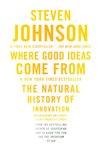
Saved by Brandon Marcus and
Where Good Ideas Come From

Saved by Brandon Marcus and
The history of being spectacularly right has a shadow history lurking behind it: a much longer history of being spectacularly wrong, again and again. And not just wrong, but messy.
If mutation and error and serendipity unlock new doors in the biosphere’s adjacent possible, exaptations help us explore the new possibilities that lurk behind those doors.
It was a process of accretion, not the linear solving of one problem after another.
suffered from too much order. If dispersed tribes of hunter-gatherers are the cultural equivalent of a chaotic, gaseous state, a culture where the information is largely passed down by monastic scribes stands at the opposite extreme. A cloister is a solid. By breaking up those information bonds and allowing ideas to circulate more freely through a
... See moreLinear information is like solids where you stick to the same form. Where your mind and society is liberated, conversations happen and good ideas flow
So part of the secret of hunch cultivation is simple: write everything down.
Exploring the adjacent possible can be as simple as opening a door. But sometimes you need to move a wall.
The same pattern occurs in the developmental history of other software genres, such as word processors, spreadsheets, or e-mail clients. They were all built out of bits, not atoms, but they took just as long to go from idea to mass success as HDTV did.
The mental recombinations of sleep helped them explore the full range of solutions to the puzzle, detecting patterns that they had failed to perceive in their initial training period.
Sleeping on it = good for thinking n clarifying thoughts
Good ideas are not conjured out of thin air; they are built out of a collection of existing parts, the composition of which expands (and, occasionally, contracts) over time.